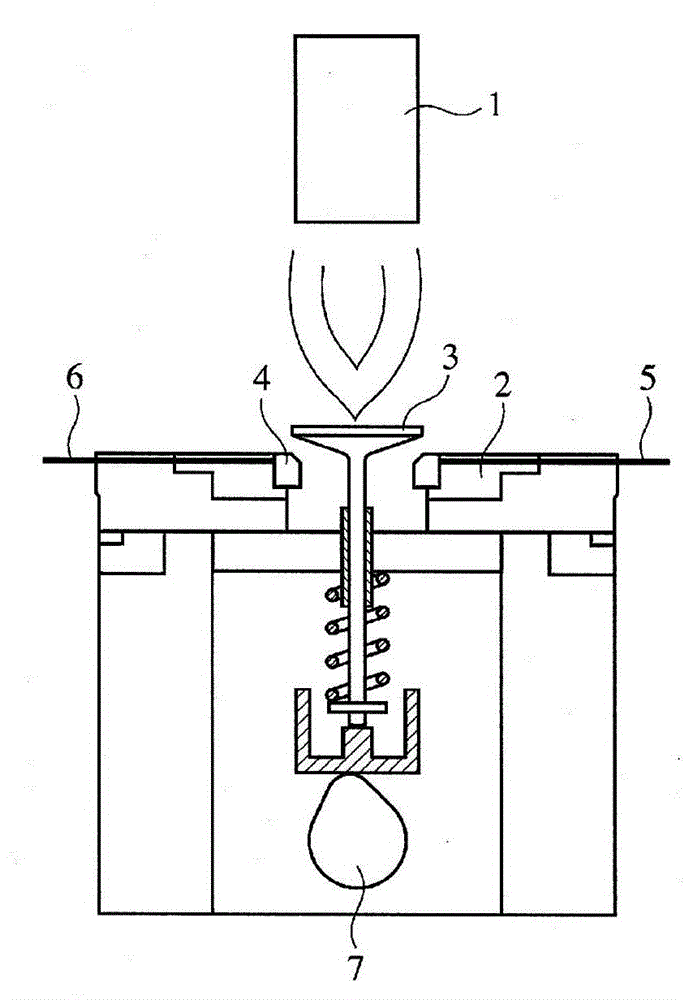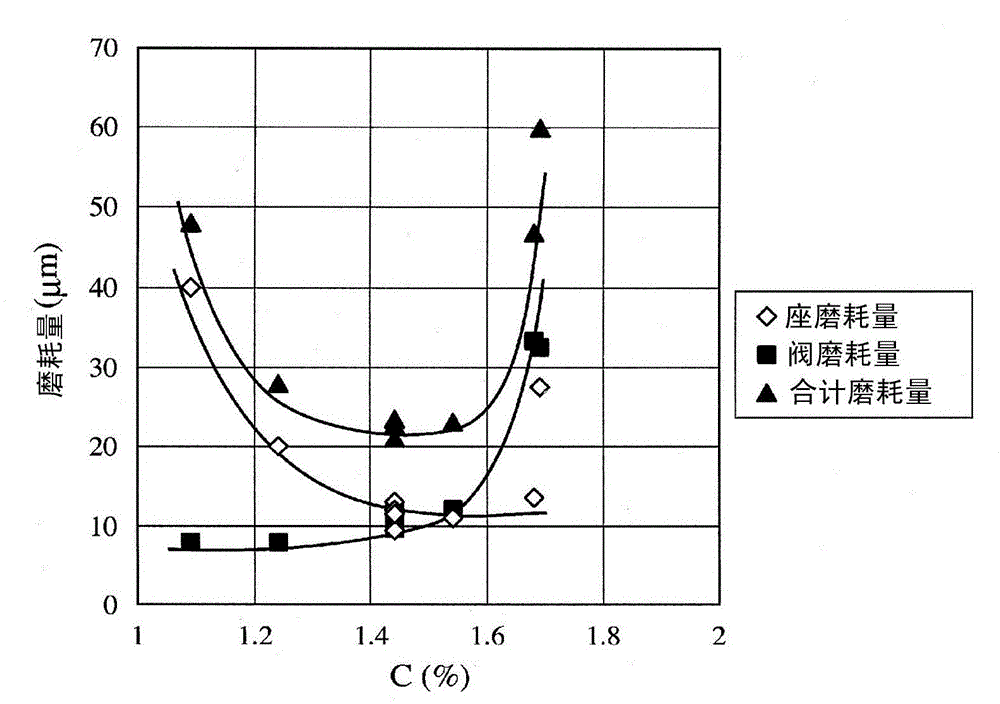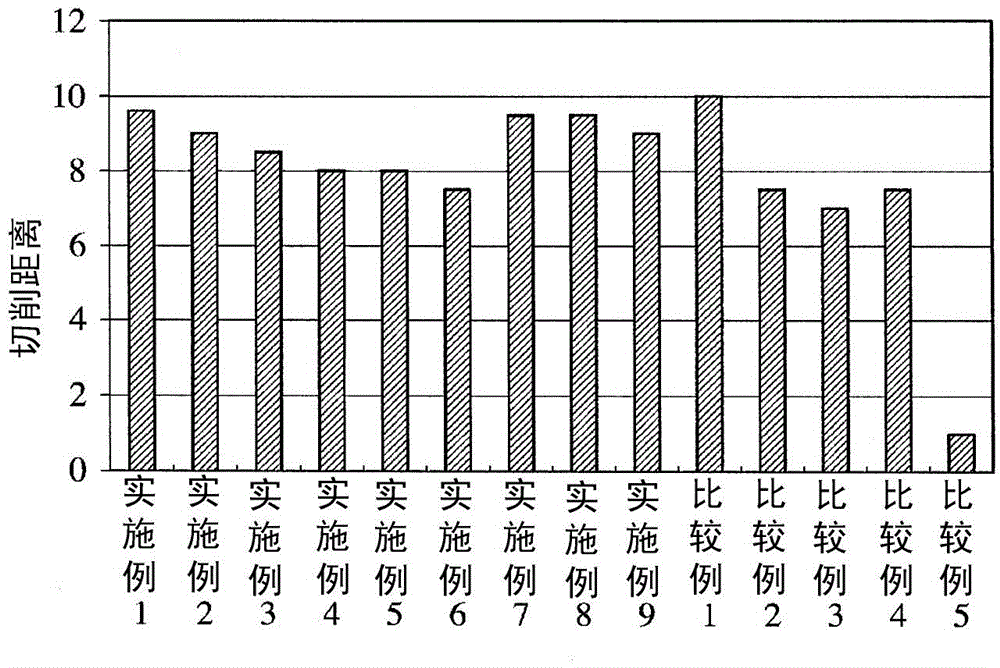Valve seat made of iron-base sintered alloy
An iron-based sintering and valve seat technology, which is applied to the parts in contact between the valve element and the valve seat, the lifting valve, the valve device, etc., can solve the problems of valve wear, poor machinability, and processing difficulties, and avoid breakage. Continuous cutting, suppression of peeling, and cost reduction effects
- Summary
- Abstract
- Description
- Claims
- Application Information
AI Technical Summary
Problems solved by technology
Method used
Image
Examples
Embodiment 1~6 and comparative example 1~4
[0027] The particle size distribution has a peak at 150-200 mesh and is composed of Cr: 11.3%, Mo: 0.96%, V: 1.9%, Si: 0.78%, C: 1.1%, balance: Fe (and unavoidable impurities) To the pre-alloyed powder, add graphite powder in a predetermined amount such that C has the matrix composition shown in Table 1, and further mix FeP which is expected to function as a liquid phase auxiliary agent. The mass of the entire alloy is 3 to 5% (Table 1 shows the mass % in the matrix.), and 10 mass % of hard particles composed of Fe-Mo-Si alloy with a Vickers hardness of Hv 1175 and an average particle size of 29 μm Or 15% by mass, kneading with a mixer to make mixed powder. Table 1 shows the mixing ratio of the matrix composition and the Fe—Mo—Si hard particles in each of Examples and Comparative Examples. In addition, 0.5% by mass of zinc stearate was added to the raw material powder based on the amount of the raw material powder in order to improve releasability in the molding step. In add...
Embodiment 7
[0040] As the hard particles, a Vickers hardness of Hv 980 and 15% by mass of Cr-W-Co-Fe alloy with an average particle diameter of 28 μm were blended, except that, the same mixing, molding, and sintering were performed as in Example 4 to produce ring-shaped particles. Sintered body. Here, the Cr-W-Co-Fe alloy used has the following composition: by mass %, Cr: 31.8%, W: 22.0%, Co: 8.4%, C: 2.1%, balance: Fe and Impurities to avoid constitute. The density and hardness of the sintered body were measured, and the wear test was also performed in the same manner as in Example 4. The composition of the matrix and the kind and mixing ratio of the hard particles are shown in Table 3, and the density and hardness of the sintered body and the results of the abrasion test are shown in Table 4.
Embodiment 8
[0042] As the hard particles, 10% by mass of the Fe-Mo-Si alloy used in Example 4 and 5% by mass of the Cr-W-Co-Fe alloy used in Example 7 were blended, except that it was the same as Example 4 Mixing, molding, and sintering are performed to produce a ring-shaped sintered body. The density and hardness of the sintered body were measured, and the wear test was performed in the same manner as in Example 4. The composition of the matrix and the kind and mixing ratio of the hard particles are shown in Table 3, and the density and hardness of the sintered body and the results of the abrasion test are shown in Table 4 together with the results of Example 7.
PUM
| Property | Measurement | Unit |
|---|---|---|
| particle diameter | aaaaa | aaaaa |
| density | aaaaa | aaaaa |
| particle diameter | aaaaa | aaaaa |
Abstract
Description
Claims
Application Information
 Login to View More
Login to View More - R&D
- Intellectual Property
- Life Sciences
- Materials
- Tech Scout
- Unparalleled Data Quality
- Higher Quality Content
- 60% Fewer Hallucinations
Browse by: Latest US Patents, China's latest patents, Technical Efficacy Thesaurus, Application Domain, Technology Topic, Popular Technical Reports.
© 2025 PatSnap. All rights reserved.Legal|Privacy policy|Modern Slavery Act Transparency Statement|Sitemap|About US| Contact US: help@patsnap.com



